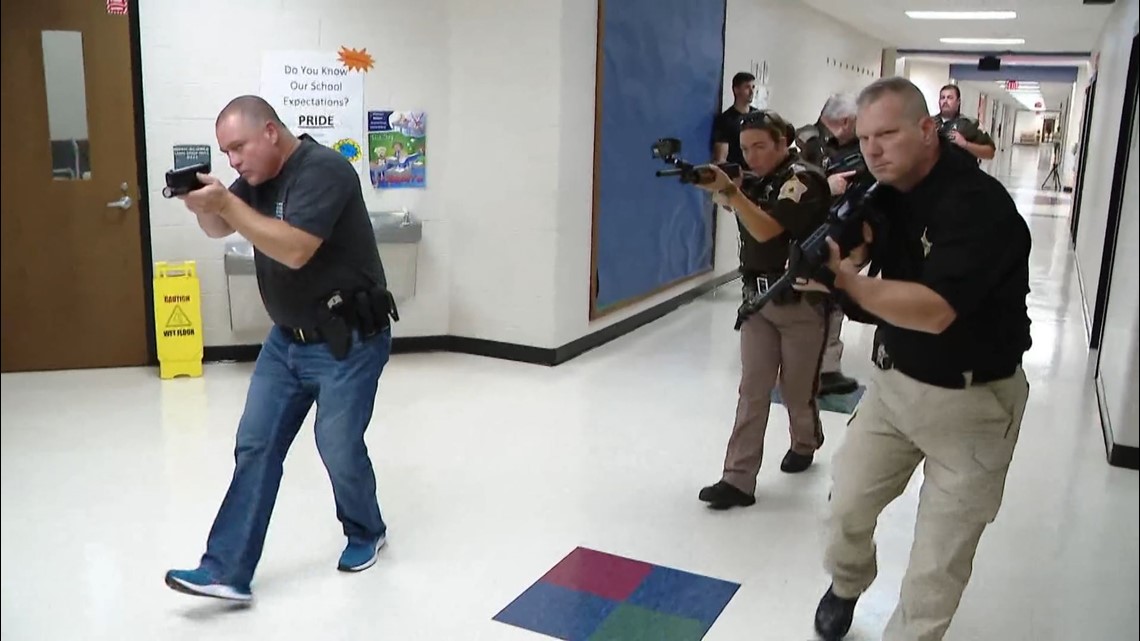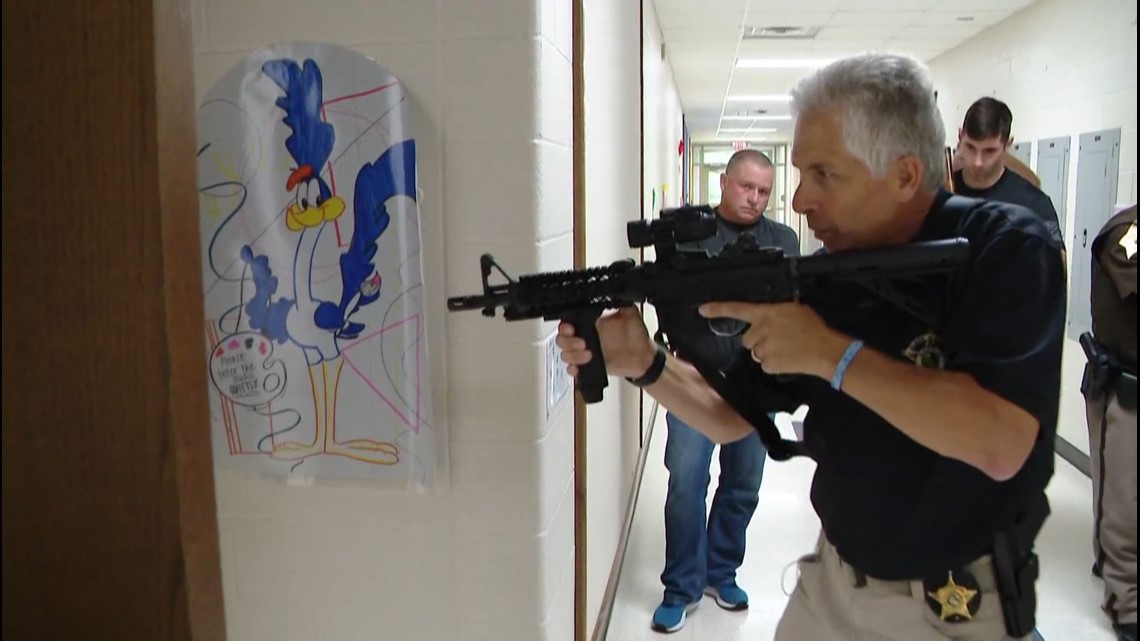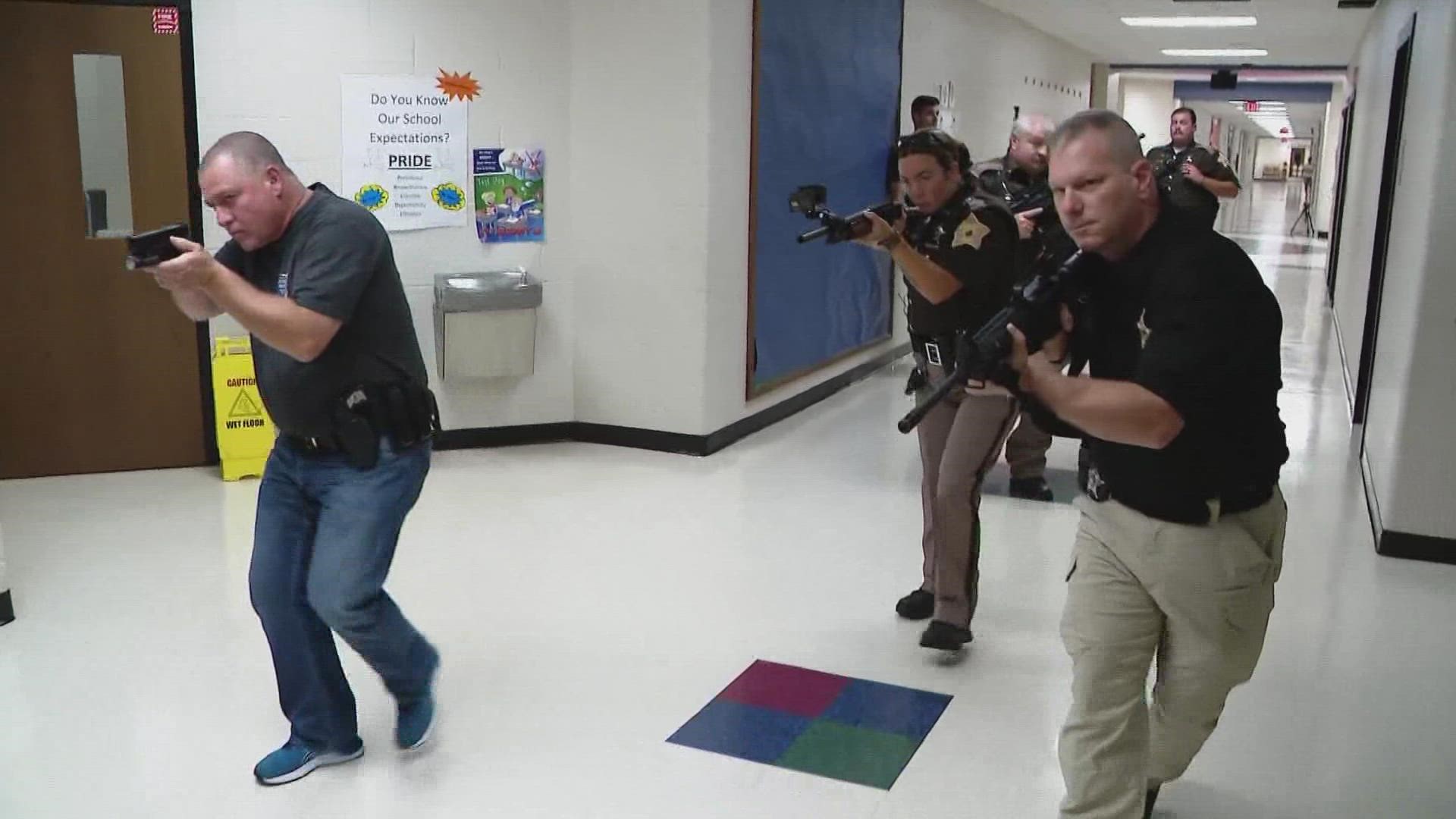'Either I die, or he dies'; Kentuckiana police vow to protect kids during school shootings
Following the tragedy in Uvalde, four local agency leaders promise parents they will not make the same "mistakes."

Thousands of Kentuckiana students are now back in the classroom, just months after 19 children and two teachers in Uvalde, Texas were killed in theirs by an 18-year-old gunman.
The scary reality is that active shooter situations could happen anywhere, but how would police respond if it happened here in Kentuckiana?
"I think about all of the children we have to protect," Jeffersontown Chief Rick Sanders said. "I want parents to know we are doing everything possible to prepare."
Surveillance video and investigative reports released weeks after the Uvalde shooting revealed none of the 350 responding officers entered the classroom, where children were being killed, for 70 minutes.
Some officers were on scene within three minutes of the first 911 call and approached the classroom, but retreated after gunman shot toward the door.
"That's scary. But that's what we're paid to do and that's what we have to do," Sanders said.
'We will not make those mistakes.' Jeffersontown Police Department
Chief Sanders says while he doesn't have all of the facts, or know exactly what happened in Uvalde, there were a lot of mistakes.
"From what I've read there were a lot of mistakes made and I just want our principals to know that we are prepared," he said. "We will not make those mistakes."
Sanders said he's recently had conversations with all the officers in his department about the courage it will take to respond to those situations and the responsibility they have to do so.
"They are prepared to risk their lives to save the lives the others," Sanders said.
The agency also recently discussed active school shooter policies, including if only one officer arrives on scene. Officers train twice a year, including doing live training in schools and classrooms, Sanders said.
"If there's an active shooter," he said. "I don't care if it's one officer, two officers, 50 officers, we're going to attack that threat."


Sanders says he put an emphasis on courage when hiring officers.
"We will only know how our people will respond, if it happens," he said. "But I feel confident we hired the right people and they have the courage it takes to approach that threat."
Sanders met with Jeffersontown principals and staff prior at the start of the new school year to review building floor plans, gain access to all classrooms, and go over communication channels between the agency, district and other departments.
"I want everyone to understand if there is an active shooter in a school, we are going to launch, we are going to attack that threat," he said. "We are not going to stand by and let that happen."
'Top priority response, everyone is coming.' Louisville Metro Police Department
The Louisville Metro Police Department is the largest police agency in Kentucky, and likely to respond to any active shooter threat in the area.
"A school shooting, or active aggressor is a top priority response for this department," Lt. Colonel Steve Healey said. "If that comes out, everyone is coming."
Healey says LMPD is well aware of what happened in Uvalde earlier this year.
"I've watched the Uvalde videos, I've read the report. As a parent myself, that is scary to think people were just standing around, trying to make a decision. I have the confidence in this departments, men and women of LMPD, our surrounding agencies and our SWAT team--they're going to go in," he said.
Healey says LMPD's training manual recommends four officers respond to an active shooter situation when possible, but that was before the department began experiencing its current staffing shortage.
LMPD leaders have since changed that recommendation in response.
"Now we're short--you have to go in," he explained, "the first officer that is on scene- they're going in."
RELATED: LMPD outlines plans moving forward to prepare for mass shooter situations; survivor weighs in
Healey says he understands this is a big ask of an officer, so LMPD has made recent upgrades to equipment to better prepare officers should they ever face the situation.
"Our younger officers are being trained on breeching. We have purchased additional breeching tools and those officers are being trained on those as well." he said.
In addition to the breeching tools and ballistic panel plates, Healey says LMPD has put in a request on this year's budget to equip every officer with a rifle.
"Our officers need to show up and not be out-gunned, so the patrol rifles are going to put us on a good level field," Healey said.
Early reports from Uvalde also indicated there may have been confusion among officers as to who was in command at the scene, something Healey says won't happen in Louisville.
"We're not going to sit around and discuss while there are gunshots and people dying," he said. "Our people are going to go in."
'We can't let that happen.' St. Matthews Police Department
St. Matthews Police Chief Barry Wilkerson says his team has been reviewing emergency response plans for area schools, daycares and after school programs including access points and possible hurdles.
"We know they're killing our kids, that's hugely important to us, we can't let that happen," Wilkerson said of a potential active shooting situation. "So that's why we train and respond the way we do."
He said his agency does both classroom training and active shooter simulations in area schools. Wilkerson added, there have been conversations about response since Uvalde.
"It's sad sometimes that it takes tragedies to get us pointed in the right direction," he said.
'Get to the threat, eliminate it.' Clark County Sheriff's Office
The Clark County Sheriff's Office just recently took their training to a local elementary school.
Last month, Riverside Elementary in the Greater Clark school district was filled with 70 officers, both on duty and reserve, learning about the most up to date techniques to stop a shooter.
"The officer's job is to get to the threat and eliminate it," Chief Deputy Scottie Maples said.
After watching the Uvalde videos, Maples said there was enough information out there to look at police's response and say, "well maybe we want to go a different path when we show up."


Maples says the department's training focused on what they called "the fatal funnel," which is the moments when an officer must breech the classroom door.
"You're going through the funnel--the shooter knows you're going through it-- pretty good chance you're going to get shot," Maples said. "So training on how we can get through that door efficiently and give our officers a leg up when we're in that gun fight."
He said not going through the door is not an option.
"There's only going to be two outcomes when we get here. Either I die, or he dies," Maples explained. "If you're actively shooting kids--there's only going to be two outcomes. And we're not going to stop until we get to that outcome."
"We're going to protect your kids at all costs," he said.
Make it easy to keep up-to-date with more stories like this. Download the WHAS11 News app now. For Apple or Android users.
Have a news tip? Email assign@whas11.com, visit our Facebook page or Twitter feed.


